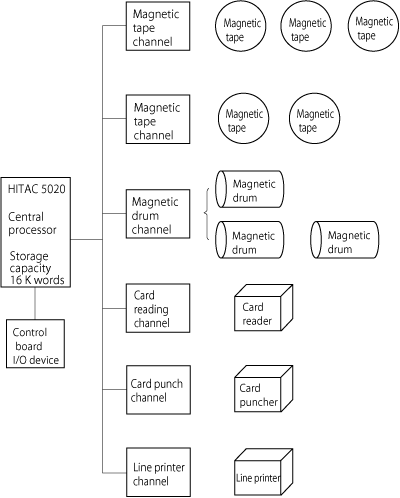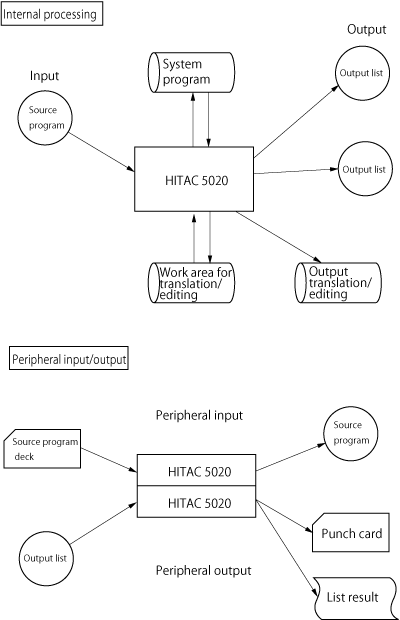HITAC 5020 was Japan’s first large, general-purpose computer to be developed using Hitachi’s unique technology. Its prototype was completed in 1964, and the first commercialized model was delivered to Kyoto University in 1965. At that time, the term “operating system” was not so commonly used, and OSs were usually called “monitor systems.” The monitor system for HITAC 5020 consisted of monitors, HARP 5020 (FORTRAN), HISAP 5020 (auto coder with FCP), routines for classification and report creation, and other programs.
(1) Monitors
The monitors were divided into a system monitor that was concerned with the whole system such as I/O operation of peripherals, allocation of I/O devices and protection of the monitor routine, and a job monitor that controlled continuous processing of each internal processing job.
The system monitor consisted of the following elements:
The monitors were divided into a system monitor that was concerned with the whole system such as I/O operation of peripherals, allocation of I/O devices and protection of the monitor routine, and a job monitor that controlled continuous processing of each internal processing job.
The system monitor consisted of the following elements:
- HICORE:HICORE: as the place for information exchange with system programs including an allocation table of storages, it resided in the magnetic core storage.
- HISUP: a control routine that directed the traffic of system programs.
- MCP: the main control program comprising a channel scheduler for multiprogramming, a routine for monitoring interrupt causes, etc.
- Routine for inputting control instructions from the operator and outputting messages to the control board.
- Routine for controlling errors, such as errors in the central processing unit and the I/O devices, and errors in programs.
- Editing routine for software maintenance.
- DUMP routine for outputting the content of the magnetic core storage and the magnetic drum.
(2) HISAP 5020 (auto coder with FCP)
An auto coder equipped with a file control system FCP (File Control Processor) enabled the user to perform programming in a symbolic language. FCP was a system that handled processing tasks such as buffering and error handling concerning the input and output of files in a unified manner. A file scheduler, serving as the main element, operated in conjunction with the MCP. In file description, correspondence between the file name and the I/O device, the type of blocking, etc. were described. Data description described data that were components of a file, and the type and length of data were described. For I/O operation, I/O macros were used. Operational macros for performing arithmetic operations, logical operations, transfer, editing, etc. against data records within the I/O area or the work area were also provided.
An auto coder equipped with a file control system FCP (File Control Processor) enabled the user to perform programming in a symbolic language. FCP was a system that handled processing tasks such as buffering and error handling concerning the input and output of files in a unified manner. A file scheduler, serving as the main element, operated in conjunction with the MCP. In file description, correspondence between the file name and the I/O device, the type of blocking, etc. were described. Data description described data that were components of a file, and the type and length of data were described. For I/O operation, I/O macros were used. Operational macros for performing arithmetic operations, logical operations, transfer, editing, etc. against data records within the I/O area or the work area were also provided.
(3) HARP 5020 (FORTRAN)
It adopted the IBM's FORTRAN IV language, and added quadruple-precision arithmetic, magnetic drum I/O statement, etc. in order to take advantage of the functions of HITAC 5020. HARP 5020 was intended to make effective use of the registry in order to increase the computing speed, including efficient control of the DO loop. In addition, statements for debugging were incorporated.
Figure 1 shows the standard equipment configuration for the HITAC 5020 system. This comprised: magnetic core storage (16 K words), magnetic tape device (2 channels, 5 units), large-capacity magnetic drum (1 channel, 3 units), card I/O device (1 unit per channel), line printer (1 channel, 1 unit), and control board I/O device (1 unit). HARP 5020 was also designed to prevent the storage from being occupied by system programs more than necessary by calling all system programs, including the monitor routine to the magnetic core storage only when necessary through use of the magnetic drum as a system file.
It adopted the IBM's FORTRAN IV language, and added quadruple-precision arithmetic, magnetic drum I/O statement, etc. in order to take advantage of the functions of HITAC 5020. HARP 5020 was intended to make effective use of the registry in order to increase the computing speed, including efficient control of the DO loop. In addition, statements for debugging were incorporated.
Figure 1 shows the standard equipment configuration for the HITAC 5020 system. This comprised: magnetic core storage (16 K words), magnetic tape device (2 channels, 5 units), large-capacity magnetic drum (1 channel, 3 units), card I/O device (1 unit per channel), line printer (1 channel, 1 unit), and control board I/O device (1 unit). HARP 5020 was also designed to prevent the storage from being occupied by system programs more than necessary by calling all system programs, including the monitor routine to the magnetic core storage only when necessary through use of the magnetic drum as a system file.



